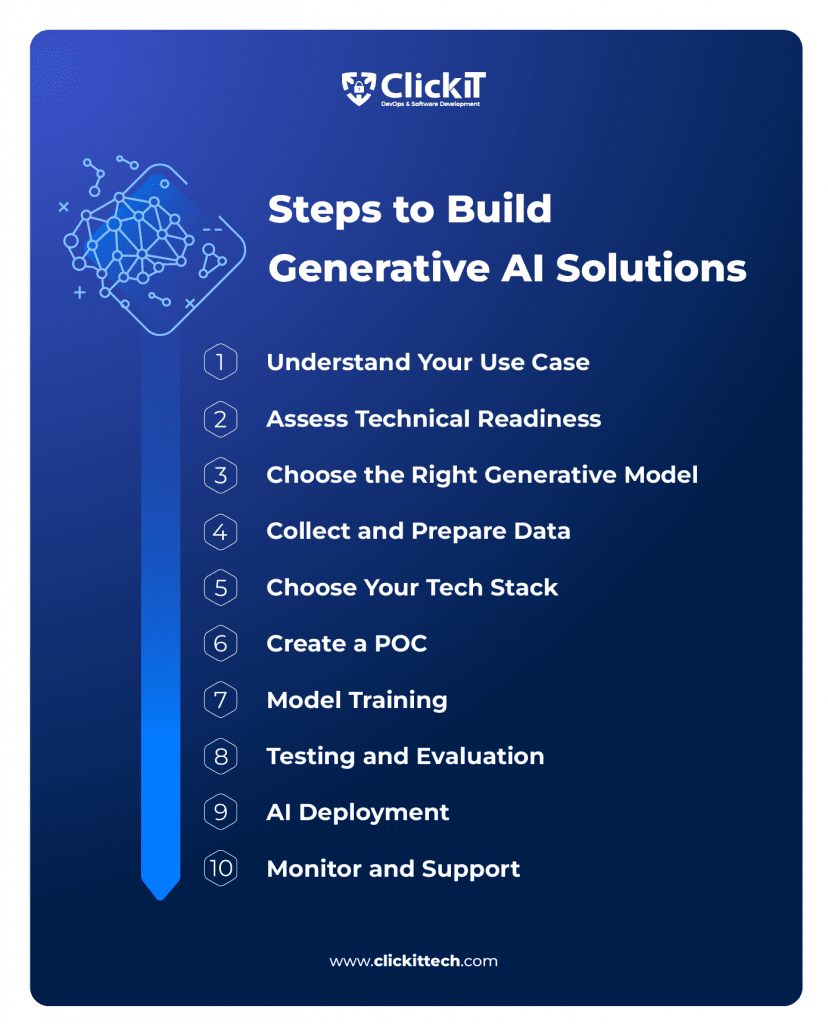Have you ever wondered how companies create customized AI solutions that captivate customers? The answer lies in Generative AI. But how to build generative AI solutions that genuinely make an impact?
In this article, I will explore how to build generative AI solutions step-by-step. Stay with me as I uncover the secrets that can revolutionize your business.
- What is Generative AI?
- How to Build Generative AI Solutions: Key 10 Steps
- How to Maintain Your Generative AI Solution for Success
- Common Applications of Generative AI
- Common Questions When Building Gen AI Solutions
What is Generative AI?
Generative AI refers to artificial intelligence systems designed to generate new, original content, such as text, images, music, or even code.
Unlike traditional AI systems that follow predefined rules to solve specific problems, generative AI learns patterns from data and uses those patterns to create something entirely new. This capability opens up a world of possibilities, from creating personalized marketing content to designing innovative products.
Key Technologies Used for Gen AI
Generative AI is powered by advanced technologies and tools that enable training and deploying complex models. Understanding how to build generative AI solutions effectively requires familiarity with these foundational technologies:
- PyTorch: An open-source machine learning framework known for its flexibility and dynamic computation graphs, making it ideal for research and production.
- TensorFlow: Another popular framework that offers comprehensive tools for building and deploying AI models, including generative ones.
- Keras: A high-level API built on TensorFlow that simplifies the creation of neural networks.
- AWS SageMaker: A fully managed service that provides tools to build, train, and deploy machine learning models at scale.
- Hugging Face: Renowned for its pre-trained models and libraries that make working with natural language processing (NLP) tasks easier.
- GANs (Generative Adversarial Networks): A specific type of neural network architecture for generating realistic images and videos.
- VAEs (Variational Autoencoders): A probabilistic model for generating new data points similar to a given dataset.
Watch our video about how to Choose Between TensorFlow vs PyTorch
How to Build Generative AI Solutions: Key 10 Steps
Building a generative AI solution involves several critical steps. Each step requires careful planning and execution to ensure the success of the final product.
- Understand Your Use Case
- Assess Technical Readiness
- Choose the Right Generative Model
- Collect and Clean Data
- Choose your Tech Stack
- Create a POC
- Model Training
- Testing and Evaluation
- AI Deployment
- Monitos and Support

Discover the AI development services ClickIT has for your business!
Step 1. Understand Your Use Case
Before diving into the technical aspects, it’s vital to identify a specific problem or opportunity that generative AI can address. This ensures your solution has a clear purpose and aligns with user needs and business goals.
- Identify the Problem: Determine whether the task involves text generation, image creation, audio synthesis, or automation.
- Evaluate Feasibility: Assess the complexity of the problem and whether generative AI is the optimal solution.
- Business Alignment: Define how solving this problem will contribute to broader business objectives.
Example Use Cases:
- Text: Personalized content creation, automated report generation.
- Images: Realistic image synthesis, design mockups.
- Audio: Voice cloning, music composition.
Step 2. Assess Technical Readiness
Evaluate your organization’s ability to support generative AI development. This includes infrastructure, expertise, and resources.
- Infrastructure Needs: Ensure access to sufficient computational power, such as GPUs or TPUs.
- Team Expertise: Identify knowledge gaps in AI development and consider upskilling or hiring.
- Resource Allocation: Plan for data acquisition, model training, and deployment costs.
Step 3. Choose the Right Generative Model
The model you choose depends on your use case and the type of content you want to generate.
For example, GPT (Generative Pre-trained Transformer) is suitable for text generation, StyleGAN excels in image synthesis, and some custom models can be tailored to your specific requirements. Your model selection should align with the goals of your project to ensure effective and efficient results.
How do you choose an AI model for a Gen AI solution?
- Modality: Modality refers to the type of data the model is designed for, such as text, images, or audio. Choose a model trained on the data type relevant to your use case (e.g., text, images, audio). For multimodal applications, select a model supporting multiple data formats.
- Size: Larger models often yield better results but can increase latency and costs. Experiment with different sizes to find the balance between quality and efficiency.
- Cost: Evaluate costs associated with training, tuning, and deployment. Some models charge by token usage or computational hours.
- Features: Ensure the model supports features like fine-tuning, prompt engineering, or grounding.
Step 4. Collect and Prepare and Clean Data
Data is essential for any AI solution. Begin by gathering diverse, high-quality datasets that align with your project needs. Data cleaning (removing errors, normalizing formats) and data labeling for training is crucial to remove inconsistencies, standardize features, and label the data accurately.
For text, this might include tokenization and removing stop words. For images, it could involve resizing and normalization. Using libraries like pandas, NumPy, and tools for data visualization will help streamline this process.
Step 5. Choose Your Tech Stack
Depending on your team’s expertise and the complexity of the task, you’ll need to decide on the following:
- AI Frameworks: TensorFlow, PyTorch, Hugging Face for pre-trained models.
- Cloud Platforms: AWS SageMaker, Google AI Platform, and Azure Machine Learning for scalable compute and model management.
- Containerization: Docker for packaging models and Kubernetes for orchestration. Ensure the stack supports continuous integration and deployment (CI/CD) for efficient model updates.

Step 6. Create a Proof Of Concept(POC)
Create a proof of concept to verify your idea before investing significant resources. The proof of concept should show that your strategy is feasible and yield preliminary findings that support the project’s objectives.
Read ClickIT’s blog about the differences between POC vs Prototype
Step 7. Model Training
Training the model is one of the most resource-intensive steps, requiring careful optimization. Here, I share some aspects you should consider for training your model:
- Hardware: Utilize GPUs or TPUs for faster processing.
- Techniques: Employ methods like transfer learning and regularization to improve efficiency. For example, fine-tuning a large pre-trained model (such as GPT for text or DALL·E for images) on your own dataset is an effective form of transfer learning that dramatically reduces the required training time and data. You can also consider Retrieval-Augmented Generation (RAG), which integrates a real-time information retrieval step so the model can pull in up-to-date, relevant data during generation without extensive retraining.
- Hyperparameter Tuning: Experiment with different configurations to enhance model performance. Try automated hyperparameter search techniques or tools to find the optimal settings.
- Tools & Libraries: Leverage robust AI frameworks and libraries such as TensorFlow or PyTorch, and community resources like Hugging Face Transformers, to streamline the training and fine-tuning process. These tools provide pre-built model architectures and utilities that simplify development, allowing your team to focus on experimentation and results.
Step 8. Testing and Evaluation
Thorough testing guarantees that your model operates as intended. For classification tasks, use metrics like accuracy, precision, recall, and F1-score; for generative models, use Inception Score (IS) and Fréchet Inception Distance (FID).
Performance metrics can be tracked and visualized with tools such as MLFlow and TensorBoard.
For generative models, the evaluation metrics will depend on the type of content generated., while text generation tasks, metrics such as BLEU or ROUGE score the quality of the AI’s output against reference texts, and perplexity measures how well the language model predicts sample data (lower perplexity indicates a better model). For image generation, metrics like Inception Score (IS) and Fréchet Inception Distance (FID) are commonly used to gauge the realism and diversity of generated images.
In addition to quantitative metrics, incorporate user-centric testing:
- User Testing: Have real users interact with the AI’s outputs. Their feedback will reveal if the generative model produces useful and coherent results in practical scenarios, helping catch issues that automated metrics might miss.**
- A/B Testing: Release two different model versions (or variations in prompts/configurations) to subsets of users and compare the outcomes. This controlled experimentation identifies which version of your generative AI model performs better or is preferred by users, guiding you toward the most effective approach.
- Iterative Refinement: Treat testing as an ongoing process. Use the findings from user feedback and A/B tests to refine your model iteratively. Update the training data or adjust model parameters in cycles, continuously improving performance and addressing any shortcomings revealed during testing.
Step 9. AI Deployment
Deploying the model requires robust frameworks and careful planning to ensure scalability and reliability.
Deployment Options:
- Embed the model into an application.
- Expose the model via REST APIs for external access.
Tools for AI deployment: Use Docker for containerization and CI/CD pipelines for automated deployment.
Step 10. Monitor and Support
Post-deployment monitoring is essential to maintain the model’s effectiveness and reliability.
- Monitoring: Track metrics like latency, accuracy, and throughput.
- Retraining Pipelines: Continuously update the model with new data to address concept drift.
- Automation: Implement pipelines for automated monitoring, retraining, and redeployment.

Summary of How to Build Generative AI Solutions
| Sr. No. | Step | Description |
| 1 | Set a Use Case | Identify the problem or opportunity you want to solve with generative AI. |
| 2 | Assess Technical Readiness | Evaluate your infrastructure, team expertise, and resources to ensure you have what’s needed for building and deploying AI solutions. |
| 3 | Choose a Generative Model | Select the appropriate generative model (e.g., GPT for text, StyleGAN for images) based on your use case and the content type to generate. |
| 4 | Collect and Prepare Data | Gather and preprocess high-quality, relevant datasets. Clean and format the data to ensure its suitability for training your model. |
| 5 | Choose Your Tech Stack | Decide on frameworks, cloud platforms, and tools (e.g., TensorFlow, AWS, Docker, Kubernetes) based on your project’s needs and your team’s expertise. |
| 6 | Create a Proof of Concept (POC) | Build a POC to verify the feasibility of your solution and refine the approach based on initial findings. |
| 7 | Model Training | Train the model using appropriate hardware (GPUs/TPUs) and techniques like transfer learning and hyperparameter tuning to optimize performance. |
| 8 | Testing and Evaluation | Test the model using metrics like accuracy, precision, recall, or FID, and refine it based on the results. |
| 9 | AI Deployment | Deploy the trained model into production, either as part of an application or as a service via APIs, ensuring scalability and reliability. |
| 10 | Monitor and Support | Continuously monitor the model’s performance, track key metrics, and maintain it by retraining with new data to improve performance and address drift. |
How to Maintain Your Generative AI Solution for Success
The journey of an AI solution doesn’t end with its deployment. Regular maintenance and continuous improvement are essential for sustained effectiveness, relevance, and user satisfaction. Generative AI systems, in particular, require meticulous oversight to adapt to changing data, user requirements, and business landscapes.
Here’s a detailed guide to maintaining your AI solution for success:
1. Regular Updates
AI models require regular updates to remain effective and aligned with evolving requirements. This involves retraining the model with new data, refining features, and incorporating the latest advancements in AI research.
- Data Refresh: Continuously integrate fresh, high-quality data to keep the model’s training dataset relevant.
- Model Retraining: Periodically retrain the model to adapt to changes in user behavior, market trends, or business goals.
- Algorithm Updates: Leverage advancements in AI algorithms or pre-trained models to improve performance and efficiency.
2. Monitor Drift
AI models can lose relevance over time due to data drift (changes in input data distribution) or concept drift (shifts in the relationship between input and output variables).
- Data Drift Monitoring: Use statistical methods to compare current input data with the original training data.
- Concept Drift Detection: Employ techniques like error rate analysis or predictive performance tracking to identify shifts in model behavior.
- Mitigation Strategies: Regularly retrain or fine-tune the model to counteract detected drifts.
3. Scalability
As your AI solution gains traction, the demand for resources may grow. Ensuring scalability is crucial to handle increased workloads efficiently.
- Cloud Infrastructure: Use cloud platforms like AWS, Azure, or Google Cloud, which offer auto-scaling capabilities.
- Containerization: Deploy models in containerized environments (e.g., Docker) for seamless scaling and portability.
- Distributed Systems: Leverage distributed training and serving frameworks like Kubernetes or Horovod for large-scale deployments.
4. Security
AI solutions often handle sensitive data and intellectual property, making robust security measures essential.
- Data Encryption: Encrypt data at rest and in transit to protect against unauthorized access.
- Access Controls: Implement role-based access controls (RBAC) to restrict access to critical systems.
- Model Security: Safeguard models from adversarial attacks and reverse engineering. Consider techniques like differential privacy or secure multi-party computation.
- Compliance: Ensure adherence to regulations like GDPR, HIPAA, or CCPA based on your domain and geography.
5. User Feedback
End-user feedback is invaluable for refining and enhancing your AI solution. I can tell you that identifying issues, improving usability, and adapting to user preferences make a huge difference.
- Feedback Channels: Provide intuitive ways for users to share feedback, such as in-app forms, surveys, or customer support.
- Data Utilization: Analyze feedback to identify patterns and prioritize improvements.
- Iterative Development: Use Agile methodologies to incorporate feedback into regular updates and releases.
6. Monitoring and Analytics
Proactive monitoring ensures that your AI system remains performant and reliable over time.
- Performance Metrics: Track metrics like latency, throughput, and accuracy to identify bottlenecks.
- Error Analysis: Regularly analyze model predictions to detect anomalies or inconsistencies.
Real-Time Alerts: Set up automated alerts for critical issues like downtime or performance degradation
7. Documentation and Knowledge Sharing
Proper documentation ensures that your AI solution is maintainable and accessible to stakeholders.
- Model Documentation: Record details about the model architecture, training process, and hyperparameters.
- Codebase: Maintain clean, modular code with clear documentation for easy updates and troubleshooting.
- Knowledge Sharing: Share insights and lessons learned to foster continuous improvement with your team.
8. Automation
Automate repetitive tasks to streamline maintenance and reduce the likelihood of human error.
- Pipelines: Set up automated workflows for data ingestion, preprocessing, model training, and deployment.
- Retraining Schedules: Use tools like Airflow or Prefect to automate periodic retraining.
Monitoring Bots: Deploy bots to monitor system health and notify teams of anomalies.

Common Applications of Generative AI
Generative AI has many applications, and learning how to build generative AI solutions can benefit many fields. Here are a few examples so you can get an idea of what kind of AI solution you are going to build:
- Content Creation: Generative AI can create articles, blog posts, and even books. Tools like GPT-3 can generate human-like text based on prompts.
- Art and Design: Generative Adversarial Networks (GANs) can generate realistic artwork, from paintings to 3D models.
- Marketing: Generative AI can create personalized ads or product recommendations based on customer data.
- Gaming: Generative models can generate game levels, characters, and environments.
- Healthcare: AI can generate drug compounds or medical images to assist in diagnosis and treatment.
In conclusion, understanding how to build generative AI solutions is essential for businesses aiming to stay ahead in the AI world. From selecting the right model to testing, deploying, and maintaining the solution, building generative AI solutions requires careful planning and execution.
It’s not just about implementing technology but understanding the business use case, preparing data, and continuously improving the model post-deployment.
Ready to build your generative AI solution? ClickIT’s AI experts can help you turn your vision into a real-world application. Explore our AI development services
Common Questions When Building Gen AI Solutions
Generative AI is a branch of artificial intelligence focused on creating new and original content, such as text, images, or audio. It’s important because it enables businesses to deliver personalized experiences, automate creative processes, and innovate in fields like design, marketing, and more.
Generative AI is used in content creation (e.g., text, images, and videos), personalized marketing, product design, virtual assistants, and creative fields like music and art. It also plays a role in simulations and predictive modeling.
Yes, you can use cloud-based services like AWS SageMaker and open-source frameworks lower the entry barrier for small businesses.
The types of data depend on the problem you’re solving. For example, in intext generation, you need large text datasets.
High-quality labeled image data is required for image generation. Similarly, audio generation needs a diverse set of sound or speech samples.
The key is having sufficient, high-quality data that reflects the diversity of use cases.
To build generative AI solutions, first identify the problem you want to solve. Then, select the right AI model (like GANs or transformers), gather and prepare relevant data, and train the model. Afterward, test the solution, deploy it into production, and continuously monitor and update it to improve performance. This concise process involves understanding the use case, leveraging data, and iterating on the model’s deployment.
Building generative AI solutions comes with several challenges. One common hurdle is obtaining quality data – generative models need diverse and relevant training data, and poor data can lead to bad outputs. Another challenge is computational cost: training these models often requires powerful hardware (GPUs/TPUs) and can be time-consuming.
There are also issues of model bias and ethical considerations, as a generative AI might produce biased or inappropriate content if not carefully monitored.
Finally, fine-tuning the model to get the right balance (e.g., making outputs creative but still accurate) often requires experimentation and expertise.






